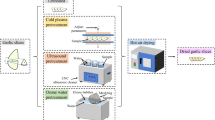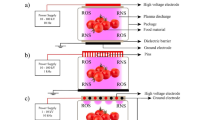Abstract
The influence of high hydrostatic pressure (HHP) on Pêra Rio orange juice was investigated using response surface methodology. A central composite design was used to evaluate the effects of three processing conditions (independent variables), namely pressure (100–600 MPa), temperature (30–60 °C) and time (30–360 s), on the native microflora and pectin methylesterase (PME) activity of orange juice. Analysis of variance showed that second-order polynomial models fitted well with the experimental data for PME residual activity (R 2 = 0.9586, p < 0.001) and aerobic microorganism count (R 2 = 0.9879, p < 0.001). The optimum HHP processing conditions to produce orange juice with PME residual activity of less than 20 % and low microorganism count (<2 log cycles CFU/mL) were 550 to 600 MPa, 55 to 60 °C and 330 to 360 s.

Similar content being viewed by others
References
AOAC. (1990). Official methods of analysis (15th ed.). Arlington, V.A.: Association of Official Analytical Chemists.
AOAC. (2011). Official methods of analysis (18th ed.). Gaithersburg, M.D.: Association of Official Analytical Chemists.
Basak, S., & Ramaswamy, H. S. (1996). Ultra high pressure treatment of orange juice: a kinetic study on inactivation of pectin methyl esterase. Food Research International, 29(7), 601–607.
Basak, S., Ramaswamy, H. S., & Piette, J. P. G. (2002). High pressure destruction kinetics of Leuconostoc mesenteroides and Saccharomyces cerevisiae in single strength and concentrated orange juice. Innovative Food Science and Emerging Technologies, 3, 223–231.
Baxter, I. A., Easton, K., Schneebeli, K., & Whitfield, F. B. (2005). High pressure processing of Australian navel orange juices: sensory analysis and volatile flavor profiling. Innovative Food Science and Emerging Technologies, 6, 372–387.
Boff, J. M., Truong, T. T., Min, D. B., & Shellhammer, T. H. (2003). Effect of thermal processing and carbon dioxide-assisted high-pressure processing on pectinmethylesterase and chemical changes in orange juice. Journal of Food Science, 68(4), 1179–1184.
Brasil (2000). Ministério da Agricultura Pecuária e do Abastecimento. Instrução Normativa No 1. de 07 de janeiro de 2000. Aprova o Regulamento Técnico Geral para fixação dos Padrões de Identidade e Qualidade para Polpa de Fruta. Brasília, Brazil.
Bull, M. K., Zerdin, K., Howe, E., Goicoechea, D., Paramanandhan, P., & Stockman, R. (2004). The effect of high pressure processing on the microbial, physical and chemical properties of Valencia and Navel orange juice. Innovative Food Science and Emerging Technologies, 5, 135–149.
Cano, M. P., Hernandez, A., & de Ancos, B. (1997). High pressure and temperature effects on enzyme inactivation in strawberry and orange products. Journal of Food Science, 62(1), 85–88.
CitrusBR (Brazilian Association of Citrus Exporters) (2012). Statistics of consumption. Available at http://www.citrusbr.com/en/citric-exporters/consumption/consumption-statistics-235206-1.asp. Accessed 12 Mar 2013.
Goodner, J. K., Braddock, R. J., & Parish, M. E. (1998). Inactivation of pectinesterase in orange and grapefruit juices by high pressure. Journal of Agricultural and Food Chemistry, 46, 1997–2000.
Hagerman, A. E., & Austin, P. J. (1986). Continuous spectrophotometric assay for plant pectin methyl esterase. Journal of Agricultural and Food Chemistry, 34(3), 440–444.
Hyoung, S. L., & Coates, G. A. (2003). Effect of thermal pasteurization on Valencia orange juice color and pigments. LWT – Food Science and Technology, 36(1), 153–156.
Irwe, S., & Olsson, I. (1994). Reduction of pectinesterase activity in orange juice by high pressure treatment. In R. P. Singh & F. A. R. Oliveira (Eds.), Minimal processing of foods and process optimization: an interface (pp. 35–42). Boca Raton: CRC.
Janzantti, N. S., Machado, T. V., & Monteiro, M. (2011). Sensory acceptance of juice from FCOJ processing steps. Journal of Sensory Studies, 26(5), 322–330.
Katsaros, G. I., Tsevdou, M., Panagiotou, T., & Taoukis, P. S. (2010). Kinetic study of high pressure microbial and enzyme inactivation and selection of pasteurization conditions for Valencia orange juice. International Journal of Food Science and Technology, 45, 1119–1129.
Krebbrers, B., Matser, A. M., Hoogerwerf, S. W., Moezelaar, R., Tomassen, M. M. M., & Van Den Berg, R. W. (2003). Combined high-pressure and thermal treatments for processing of tomato puree: evaluation of microbial inactivation and quality parameters. Innovative Food Science & Emerging Technologies, 4(4), 377–385.
Lawlor, K. A., Schuman, J. D., Simpson, P. G., & Taormina, P. J. (2009). Microbiological spoilage of beverages. In W. H. Sperber & M. P. Doyle (Eds.), Compendium of the microbiological spoilage of foods and beverages (pp. 245–284). New York: Springer.
Naim, M., Schutz, O., Zehavi, U., Rouseff, R. L., & Haleva-Toledo, E. (1997). Effects of orange juice fortification with thiols on p-vinylguaiacol formation, ascorbic-acid degradation, browning, and acceptance during pasteurization and storage under moderate conditions. Journal of Agricultural and Food Chemistry, 45(5), 1861–1867.
Nienaber, U., & Shellhammer, T. H. (2001). High-pressure processing of orange juice: combination treatments and a shelf life study. Journal of Food Science, 66(2), 332–336.
Ogawa, H., Fukuhisa, K., Kubo, Y., & Fukumoto, H. (1990). Pressure inactivation of yeasts, molds and pectinesterase in Satsuma mandarin juice: effects of juice concentration, pH, and organic acids, and comparison with heat sanitation. Agricultural and Biological Chemistry, 54(5), 1219–1225.
Parish, M. E. (1998). High pressure inactivation of Saccharomyces cerevisiae, endogenous microflora and pectinmethylesterase in orange juice. Journal of Food Safety, 18, 57–65.
Patterson, M. F. (2005). Microbiology of pressure-treated foods. Journal of Applied Microbiology, 98(6), 1400–1409.
Polydera, A. C., Galanou, E., Stoforos, N. G., & Taoukis, P. S. (2004). Inactivation kinetics of pectin methylesterase of Greek Navel orange juice as a function of high hydrostatic pressure and temperature process conditions. Journal of Food Engineering, 62, 291–298.
Rodrigues, M. I., & Iemma, A. F. (2009). Planejamento de Experimentos e Otimização de Processos. Campinas: Ed Cárita.
Timmermans, R. A. H., Mastwijk, H. C., Knol, J. J., Quataert, M. C. J., Vervoort, L., Van Der Plancken, I., et al. (2011). Comparing equivalent thermal, high pressure and pulsed electric field processes for mild pasteurization of orange juice. Part I: impact on overall quality attributes. Innovative Food Science and Emerging Technologies, 13, 235–243.
Tribess, T. B., & Tadini, C. C. (2006). Inactivation kinetics of pectin methylesterase in orange juice as a function of pH and temperature/time process conditions. Journal of the Science of Food and Agriculture, 86, 1328–1335.
Van Den Broeck, I., Ludikhuyze, L. R., Van-Loey, A. M., & Hendrickx, M. E. (2000). Inactivation of orange pectinesterase by combined high-pressure and temperature treatments: a kinetic study. Journal of Agricultural and Food Chemistry, 48, 1960–1970.
Versteeg, C., Rombouts, F. M., Spaansen, C. H., & Pilnik, W. (1980). Thermostability and orange juice cloud destabilizing properties of multiple pectinesterases from orange. Journal of Food Science, 45(4), 969–971.
Vervoort, L., Van Der Plancken, I., Grauwet, T., Timmermans, R. A. H., Mastwijk, H. C., Matser, A. M., et al. (2011). Comparing equivalent thermal, high pressure and pulsed electric field processes for mild pasteurization of orange juice. Part II: impact on specific chemical and biochemical quality parameters. Innovative Food Science and Emerging Technologies, 12, 466–477.
Acknowledgments
The authors would like to thank FAPESP (São Paulo Research Foundation) for the financial support (no. 2011/11574-2) and JBT FoodTech, Araraquara, SP, Brazil for supplying the orange juice.
Author information
Authors and Affiliations
Corresponding author
Rights and permissions
About this article
Cite this article
Bisconsin-Junior, A., Rosenthal, A. & Monteiro, M. Optimisation of High Hydrostatic Pressure Processing of Pêra Rio Orange Juice. Food Bioprocess Technol 7, 1670–1677 (2014). https://doi.org/10.1007/s11947-013-1176-7
Received:
Accepted:
Published:
Issue Date:
DOI: https://doi.org/10.1007/s11947-013-1176-7




